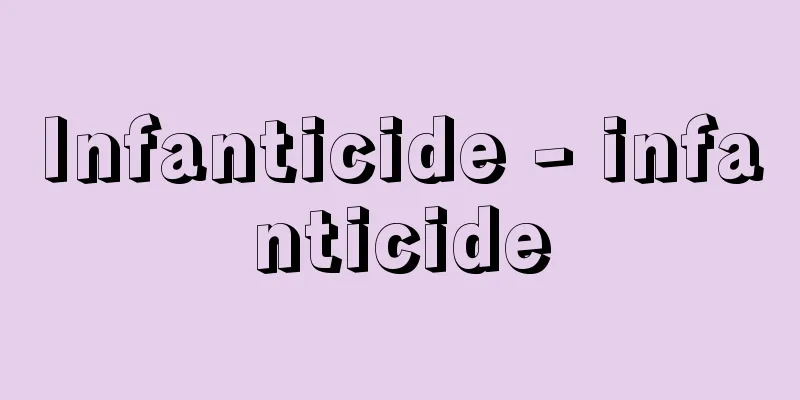Infanticide - infanticide

|
It is the killing of a baby shortly after birth, usually by the parents or someone directly related to the parents. Infanticide is a phenomenon that exists throughout all ages and in both "primitive" and "civilized" cultures, but while in "primitive" cultures it is an accepted act within that culture, in civilized societies it is often treated as a crime. The reasons for infanticide are difficult to speculate on, but they can be roughly divided into three categories: (1) environmental problems such as food shortages and harsh climates, (2) symbolic and cognitive problems such as the killing of one or both twins, and (3) causes related to the parent or child, such as birth defects in the child or mental and physical instability of the parents. Famous anthropological examples include female infanticide among the Eskimos and the Toda people of India, both of which are said to be closely related to the ecosystems and marriage systems of their respective societies. Twins also confuse the premise that humans are originally born one at a time, and infanticide is thought to be practiced to solve this cognitive problem. In civilized societies, infanticide is treated as a form of parent-child suicide, abuse, or abandonment of a corpse, and is subject to punishment, but even in so-called primitive societies, as the ideas of modern society have infiltrated, infanticide has come to be viewed as a sin. [Etsuko Matsuoka] Criminal InfanticideIn criminal law, it is called infanticide, and it is the killing of a newborn baby during or immediately after birth. In the past, there was a view in legislation regarding infanticide that it should be severely punished because it is the killing of a defenseless baby (Carolina Code), but today, on the contrary, there are many cases where infanticide is distinguished from ordinary murder and punished lightly. The reasons given include that it is often committed when the mother is in a special mental state at the time of birth, and that it is sometimes committed to prevent the smear of a mother's reputation by giving birth out of wedlock. Many foreign countries have provisions for infanticide in their criminal codes, but the Japanese criminal code does not distinguish between infanticide and ordinary infanticide. Therefore, infanticide before or after "birth" constitutes the crime of abortion (Article 212 and following of the Penal Code), and after birth constitutes the crime of murder (Article 199 of the Penal Code). There is some debate about the timing of "birth," with theories including the labor pains theory, the partial exposure theory, the complete exposure theory, and the independent breathing theory. According to the prevailing theory and legal precedents, when an infant is completely inside the mother's womb, it is only considered an abortion, but killing an infant that is even partially exposed outside the mother's womb constitutes murder (Note that in countries that have provisions for infanticide, the labor pains theory is generally adopted). However, in Japan, a wide range of statutory penalties are provided for the crime of murder, so even in cases where infanticide constitutes murder, if there are extenuating circumstances such as those mentioned above, the sentence may be determined taking those circumstances into consideration. [Tetsuro Nawa] [References] | | |Source: Shogakukan Encyclopedia Nipponica About Encyclopedia Nipponica Information | Legend |
|
誕生直後に赤ん坊を殺すことであるが、通常、親か親と直接に関係のある者によって殺害がなされた場合をさす。嬰児殺しはあらゆる時代を通じ、また「未開」と「文明」を問わず存在する現象であるが、「未開」の場合はその文化のなかで認められた行為であるのに対し、文明社会においては犯罪として扱われることが多い。嬰児殺しの理由を推し測ることはむずかしいが、次のように大きく三つに分けることができよう。(1)食糧不足、厳しい風土などの環境上の問題、(2)双生児の一方か両方を殺すことにみられる象徴的・認識的問題、(3)子供の形態異常や親の心身の不安定などの親か子に原因がある場合、である。 人類学的に有名な例としては、エスキモーの女児殺し、インドのトダ人の女児殺しがあり、いずれもそれらの社会の生態系や婚姻システムと密接に関連しているとされる。また双生児は、人間の子は本来1人ずつ生まれるという前提を混乱させるものであり、その認識上の問題を解決するために嬰児殺しが行われると考えられる。文明社会における嬰児殺しは、親子心中や虐待、死体遺棄として取り上げられ、処罰の対象とされているが、いわゆる未開社会においても、近代社会の考え方が入り込むにつれ、嬰児殺しは罪と意識されるようになってきている。 [松岡悦子] 刑法上の嬰児殺刑法上は嬰児殺(えいじさつ)といい、分娩(ぶんべん)中または分娩直後の新生児を殺害すること。嬰児殺に関する立法例には、古くは、嬰児殺が無抵抗の嬰児を殺害するものであるから重く処罰されるべきであるという考え方(カロリナ法典)があったが、今日ではむしろ逆に、嬰児殺を普通の殺人と区別して、これを軽く処罰する例が多い。その理由には、出産時における母親の特殊な精神状態のもとで犯されることが多いことや、非嫡出子出産により名誉が傷つけられることを防ぐために犯される場合があること、などがあげられている。 諸外国の刑法には嬰児殺の規定を設けているところが多いが、日本の刑法は嬰児殺と普通殺とを区別していない。したがって、嬰児殺しは、「出生」の前・後により、出生前であれば堕胎罪(刑法212条以下)、出生後であれば殺人罪(刑法199条)が成立することになる。なお、「出生」の時期については争いがあり、陣痛説、一部露出説、全部露出説、独立呼吸説などがあるが、一部露出説とよばれる通説・判例の立場によれば、嬰児殺のうち、嬰児が完全に母体内にある場合には堕胎罪にとどまるが、母体外に一部でも露出した嬰児を殺害する場合は殺人罪になる(なお、嬰児殺の規定を設けている国では、嬰児について陣痛説が一般的に採用される)。ただし、日本では、殺人罪には幅広い法定刑が規定されているから、嬰児殺が殺人罪にあたる場合にも、先に述べたような同情すべき事情が認められるならば、その情状を考慮して刑を量定すればよいであろう。 [名和鐵郎] [参照項目] | | |出典 小学館 日本大百科全書(ニッポニカ)日本大百科全書(ニッポニカ)について 情報 | 凡例 |
<<: Poetry of history - yŏng shǐ shī
Recommend
Imakita Hongcheon
Year of death: January 16, 1892 (Meiji 25) Year of...
Kotosh (English spelling)
This ruin is located on the right bank of the Hig...
Paphos (personal name) (English spelling) Paphos
…(1) A king of Cyprus. He fell in love with an iv...
Australopithecus afarensis
A type of ape-man. It was named in the late 1970s ...
Hunting rifle - Ryoju
Generally speaking, firearms for capturing birds ...
failure rate
…These characteristic values are explained belo...
Kameya Kumakichi
…In 1644, German Jesuit priest A. Kircher invente...
Shishiudo - Shishiudo
A large perennial plant of the Umbelliferae famil...
Diplazium esculentum (English spelling) Diplaziumesculentum
…[Masahiro Kato]. . . *Some of the terminology th...
Uchiosso - The late monk
Date of birth and death unknown. Painter of the e...
Cavolinia longirostris (English spelling) Cavolinialongirostris
…[Tadashige Nabe]. . … *Some of the terminology t...
Yuzhnyi Bug (English notation) YuzhnyiBug
…A river in southern Ukraine. Also known as the Y...
Rice supply - Kyumai
〘 noun 〙 Rice given as salary. In the Edo period, ...
Noise - Souon (English spelling)
Generally, noise is any sound that is unpleasant ...
Anzai Fuyue
Poet. Born in Nara City. Graduated from Sakai Mid...









